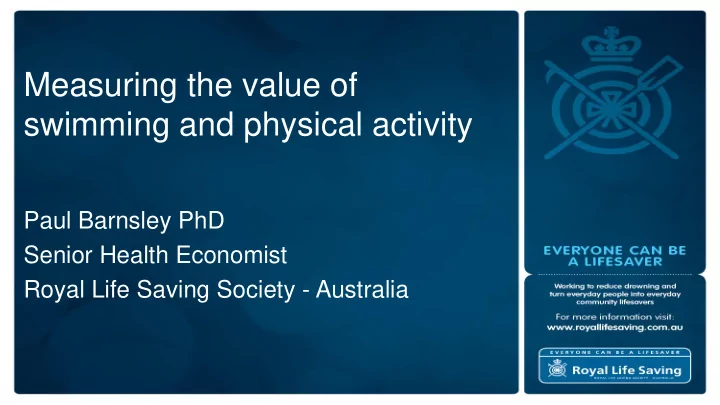

Measuring the value of swimming and physical activity Paul Barnsley PhD Senior Health Economist Royal Life Saving Society - Australia
Benefits of aquatic activity • Physical inactivity leads to • 40% of Australians are classified as “inactive” massive health costs – 5% of Australia’s burden of – For most of these people, an disease and injury is due to additional weekly swimming pool visit would move them to “low inactivity activity” – Total annual costs due to inactivity are at least $55 billion
Current distribution of physical activity 1% WHO cut-offs for physical activity levels: 7% • <600 MET.minutes/week – Physically inactive 39% • 600-4,000 MET.minutes/week – Low activity • 4,000-8,000 MET.minutes/week – 53% Moderate activity • >8,000 MET.minutes/week – High activity Inactive Low activity Moderate activity High activity
Valuing increases in activity 35% • Categories of gains from increased 30% activity: 25% 20% – Value of reduced mortality and morbidity 15% – Reduced healthcare spending 10% – Reduced absenteeism 5% 0% Inactive Low activity Moderate activity Average increase in relative risk, compared to high activity
Valuing reduced death and disability Delaying premature mortality: Reducing disability • • Delaying mortality for one year is A Disability Adjusted Life Years valued using the Value of a Statistical (DALYs) measure the proportional Life Year (VSLY) impairment caused by disability or morbidity – RLSSA calculated the 2016 VSLY at – Living four years with a 25% $198,000 – Same methodology is used to value impairment (eg moderate traumatic brain injury) generates one DALY public health interventions – AIHW figures for physical inactivity list total DALYs, combining mortality and morbidity
Valuing health care costs • Project annual spending on • AIHW figures show % of inactivity-linked conditions burden attributable to inactivity – Type II Diabetes ($3 bn) for each condition – Cardiovascular disease ($11 bn) – Assume cost share is equal to burden – Breast & bowel cancers ($7 bn) share – Ignores general health system costs due to inactivity-linked morbidity – Inactivity generates 5% of burden, but only 2.15% of costs
Valuing lost productivity • Hard to link physical inactivity • Sick days are valued using to specific workplace average weekly earnings outcomes – Estimate includes costs of managerial hours to replace absent employee – We adopt a conservative approach – Includes a partial overtime premium – Medibank study suggests inactivity – Ignores presenteeism: reduced leads to two extra sick days per year productivity for low activity persons – No evidence for differences between low, moderate and high activity levels
Where do the gains come from? $5,000 Breakdown of gains from becoming active $4,500 $4,000 $3,500 $742 $3,000 $2,500 $202 $2,000 $2,447 $1,500 $1,000 $500 $0 Health value Health care costs Absenteeism Inactive Low activity Moderate activity
Extra pool visits reduce inactivity • We used a Monte Carlo • We calculated how much one simulation to randomly assign pool visit changed national millions of extra pool visits activity profile on average across the Australian population – Most gains come from getting “inactive” people up to “low activity” – Simulation used exact distribution of MET.minutes within each category
How much extra value? • An average pool visit is 555 • An average facility creates MET.mins of exercise $2.72m in health benefits each year – “inactive” is <600 MET.mins/week • The aquatic industry creates • An average visit has health $2.8 billion in wider economic benefits worth $26.39 benefits annually
What else do we need to know? • These figures are for an • With the right data, we can average Australian aquatic tailor estimates to a specific facility facility, whether existing or proposed • Different visitor demographics • Figures are for a marginal, not lead to different benefit profiles average visit
What about the other benefits? • Economic contribution to the • Visitors’ enjoyment area – Some evidence on this, can be improved by looking at how far – Important, but difficult to people are willing to travel measure and govt increasingly • Community/inclusion benefits sceptical • Gains from improved aquatic – Important, but hard to pin down education to a dollar figure – Hard to tie a particular facility to any future reduction in drowning
What are the policy implications? • The aquatic industry generates value to the public far above the money it collects from visitors • Government decision making should keep physical activity benefits in mind when making changes impacting on access to pools
Recommend
More recommend